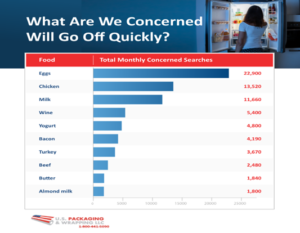
Eggs ranked number one most worrying food for going bad
With US shoppers seeing the highest increase in their grocery bills since the 1970s, it’s unsurprising many are trying to cut costs where possible and not let foods go to waste.
However, some are taking this to the extreme. A recent survey in the UK, where soaring inflation rates are hitting families hard, found almost a third of respondents admitted to having eaten food past its use-by date at least once a month because they could not afford to buy more, while 18 percent had turned off their fridge or freezer to save money on their energy bill.
But eating spoilt foods and improper storage can prove very dangerous. According to the World Health Organisation, one in 10 people will fall ill from eating contaminated food, contributing to 420,000 deaths in the US each year.
To understand which household staples are causing the most confusion for Americans and help reduce unnecessary food waste, data analysts at food packaging experts US Packaging & Wrapping used Google search data to discover the most concerning foods for going bad.
In first place is eggs, with 22,900 concerned searches each month. Not only is it the most searched food for safety around expiration dates, but it also tops the tables for questions about sell-by dates.
While best-by dates commonly found on cartons only indicate when the quality of eggs will begin to deteriorate, typically eggs can be eaten for some time after this. Most eggs have a healthy shelf-life of up to five weeks, with refrigeration needed to achieve optimal safety. You should be mindful to avoid storing eggs in your fridge door since the opening and closing motion can create fluctuating temperatures that will speed up rotting.
There are a couple of tricks you can use to test whether an egg has gone off before cracking it open. First, you can fill a bowl with cold water to see if the egg floats. A fresh egg will sink however, if the egg floats this means the egg is no longer as moist and air bubbles will have collected inside, a sure indicator the egg has rotten. You can also try shaking the eggs. If you hear any sloshing noises, throw them out. If all else fails, crack open the egg and inspect for any deterioration in appearance or a bad smell.
In second place is chicken, with 13,520 monthly searches. Chicken not only ranks highly for searches around consuming after expiration and sell-by dates, but is also the most concerning food for eating after freezing. Considering the CDC estimates a million Americans fall ill from eating contaminated poultry every year, it’s unsurprising many are worried about the correct way to store and consume chicken.
The biggest concern consumers face is how to defrost chicken safely. A refrigerator is always the safest option for thawing meat at a consistent temperature with little risk of bacteria forming. Just be sure to allow plenty of time for the chicken to thaw out completely (around 48 hours for large cuts) and keep all meat at the bottom of your fridge to avoid any risk of drippings causing cross-contamination. Resealable vacuum bags could help prevent any cross-contamination while reducing bulky containers and freeing up more space in your freezer.
Milk takes third place, with 11,660 monthly searches. This is in spite of milk consumption steadily declining and dairy-free milk alternatives such as Almond Milk (ranking 10th position) becoming more popular. It seems that milk is still a staple among American households, despite greater concern about milk expiring quickly.
Most expiration dates are accurate for milk products and should be paid attention to. However, it is possible to get away with pushing the boundaries for an extra day or two by looking out for the tell-tale signs of milk expiring, including a bad smell, thickness and a lumpy appearance.
Wine (11,600) and yogurt (4,800) completed the top five positions respectively.
Charles Haverfield, Packaging Expert at US Packaging and Wrapping, commented:
“It’s clear food safety is a big concern among consumers. And with 48 million people in the US alone falling sick from food-borne illnesses, it’s no surprise we are wary of the foods we eat.
“But with USDA statistics showing the average American household wastes up to 40 percent of their food each year, it’s also clear there is confusion around throwing away otherwise safe foods. From sell-by labels causing uncertainty, to a lack of knowledge around frozen foods and proper storage of opened products, there is some way to go to help improve public understanding and reduce the US’ food waste problem.”
To view the full study, click here.
About US Packaging and Wrapping:
U.S. Packaging & Wrapping is a full service, customer-driven packaging supply company. We are dedicated to providing superior products and service at an affordable price. Our staff takes pride in the ability to inform customers about various packaging options. Headquartered in Central Arkansas with shipping warehouses on the east and west coast, we strive for fast and affordable shipping.










